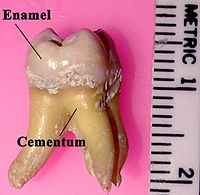
Photo from wikipedia
Abstract The structural integrity of the sealant is critical for the reliability of solid oxide cells (SOCs) stacks. In this study, elastic modulus (E), hardness (H) and fracture toughness (KIC)… Click to show full abstract
Abstract The structural integrity of the sealant is critical for the reliability of solid oxide cells (SOCs) stacks. In this study, elastic modulus (E), hardness (H) and fracture toughness (KIC) of a rapid crystallizing glass of BaO–CaO–SiO2 system termed “sealant G” are reported as determined using an indentation test method at room temperature. A wide range of indentation loads (1 mN–10 N) was used to investigate the load-dependency of these mechanical properties. Values of 95 ± 12 GPa, 5.8 ± 0.2 GPa and 1.15 ± 0.07 MPa m0.5 were derived for E, H and KIC using the most suitable indentation loads. An application relevant annealing treatment of 500 h at 800 °C does not lead to a significant change of the mechanical properties. Potential self-healing behavior of the sealant has also been studied by electron microscopy, based on heat treatment of samples with indentation-induced cracks for 70 h at 850 °C. Although the sealant G is considered to be fully crystallized, evidence indicates that its cracks can be healed even in the absence of a dead load.
Journal Title: Ceramics International
Year Published: 2020
Link to full text (if available)
Share on Social Media: Sign Up to like & get
recommendations!